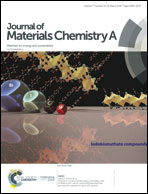Achieving a fine balance between the strong mechanical and high thermoelectric properties of n-type PbTe–3% Sb materials by alloying with PbS†
Abstract
Both p- and n-type PbTe based materials exhibit excellent thermoelectric properties. However, their mechanical properties are relatively poor compared to those of state-of-the-art thermoelectric materials. In this work, we try to obtain a balance between the strong mechanical properties and high thermoelectric properties of n-type PbTe–3% Sb materials by alloying with PbS. The results indicate that the elastic moduli remain almost unchanged, while the microhardness increases by 62% from a reference value of 54.2 kg mm−2 to approximately 88 kg mm−2 after alloying with PbS (<15%) at room temperature, which is comparable to or even higher than those of common thermoelectric materials. Such a great enhancement of microhardness costs only 7.4% reduction of the dimensionless figure of merit (ZT). A high ZT value of ∼1.5 at 823 K is still maintained. Achieving this fine balance between strong mechanical properties and high thermoelectric properties is crucial to the practical applications of PbTe materials in the electricity generation field.



 Please wait while we load your content...
Please wait while we load your content...